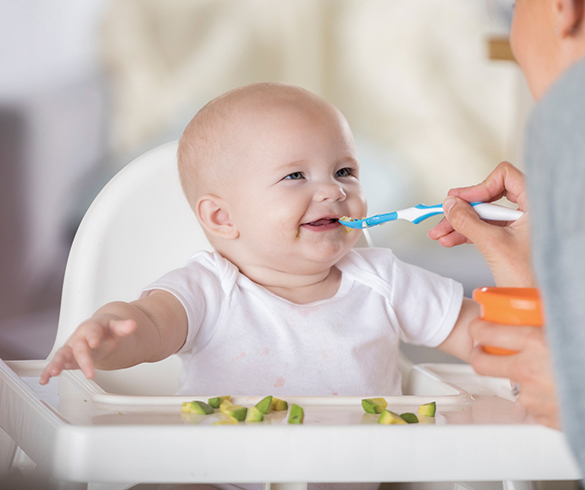
Love at First Taste: Tips for introducing solid foods to your baby
Tips for introducing solid foods to your baby
Throughout a child’s first years of life, there are several milestones for marking growth, development and progress toward maturity. As many parents can attest, few of those milestones are as messy, imperfect and joyful as those associated with a baby’s first tastes of new foods and flavors.
The 2020-25 Dietary Guidelines for Americans recognize that from 6-24 months is a key age range for building healthy eating patterns with a variety of foods such as vegetables, fruits and whole grains. Starting solid foods, such as oatmeal or pureed vegetables and fruits, is the first step. However, beginning this journey can often bring parents additional stress as they question what and how much is right to feed their child.
Get your little one on the path to a lifetime of healthy eating habits with these tips from Dr. Whitney Casares, pediatric consultant for Gerber.
 Let the journey begin
Let the journey begin
Check with your pediatrician before starting any solid foods. Most babies are ready for solid foods around 6 months, but it’s important to not offer solids before 4 months.
Around the middle of the first year of life, it is important for your baby to get iron from the foods he or she eats, especially if breastfed. Iron-fortified baby cereal can help provide this important nutrient to support healthy growth and brain development.
Some signs your baby is ready for solid foods are when he or she has good head control, sits up with help or support, brings objects to his or her mouth and seems interested in food others are eating.
For the first attempts at feeding solids, pick a time of day when your baby is in good spirits, wide awake and mildly hungry. You can offer breastmilk or formula before solids, if necessary, so your child is not uncomfortably hungry.
Make sure your baby is sitting up and secured in a highchair. Use a soft, rubber-tipped spoon and start by guiding the spoon to your baby’s mouth with both your hand and your child’s hand on the spoon.
Introducing first tastes
Purees and infant cereal are wholesome and developmentally appropriate options for discovering solid foods and can help your baby discover a variety of flavors. Baby cereal is a good starting point for most babies because you can mix it with breastmilk or formula, and it is fortified with iron. This familiar taste can help your baby accept the new taste and texture of cereal.
While stage-appropriate purees can be made at home, another way to make your transition to solids easy is with an option like Gerber’s My 1st Starter Kits that come with fruit and vegetable varieties making it simple for parents to introduce baby to high-quality, nutritious and appropriate foods.
Follow baby’s lead
Your baby’s first tries at swallowing solid foods may be awkward and will likely require practice. If food is rejected, offer a few more spoonfuls and gauge your child’s response to decide whether to continue or try again another day.
Responsive feeding is an approach that helps set your baby up for healthy eating habits. Observing your child’s reactions can help determine if he or she is adventurous or cautious, hungry or full. All of this can help you feed in a manner best suited for your baby. Look for cues your child is interested in eating more – smiling or reaching toward the spoon – as well as those that indicate fullness such as turning away, pushing the spoon away, leaning away from the spoon, shaking his or her head or spitting food out.
Alternatively, baby-led weaning emphasizes exploration – of tastes, textures, colors and smells – and encourages baby to self-feed whole pieces of food cut into strips or small pieces. Spoons can also be pre-loaded for him or her, and this approach also promotes the development of gross and fine motor skills, hand-eye coordination and chewing.
For more expert tips on introducing your baby to solids, visit Gerber.com.
Source:
Gerber



























